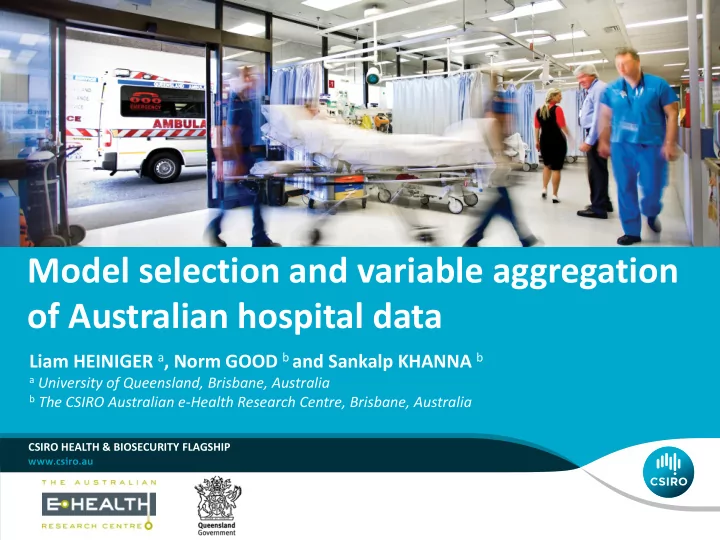

You can change this image to be appropriate for your topic by inserting an image in this space or use the alternate title slide with lines. Note: only one image should be used and do not overlap the title text. Enter your Business Unit or Flagship name in the ribbon above the url. Add collaborator logos in the white space below the ribbon. [delete instructions before use] Model selection and variable aggregation of Australian hospital data Liam HEINIGER a , Norm GOOD b and Sankalp KHANNA b a University of Queensland, Brisbane, Australia b The CSIRO Australian e-Health Research Centre, Brisbane, Australia CSIRO HEALTH & BIOSECURITY FLAGSHIP
Patient Flow @ CSIRO AEHRC Enabling hospitals to better manage their resources & hence reduce waiting times www.csiro.au/patientflow 2 | Model selection and variable aggregation of Australian hospital data
Project Background • National Emergency Access Target (NEAT): The percentage of patients who present to the Emergency Department and are waiting for more than four hours • Hospital Standardised Mortality Rate (HSMR): ratio of actual number of deaths to expected number of deaths • Looking at the relationship between NEAT and HSMR • Our focus here : • Predicting the probability of death for patients using Statistical Modelling 3 | Model selection and variable aggregation of Australian hospital data
UNDERSTANDING THE PROBLEM 4 | Model selection and variable aggregation of Australian hospital data
Problem Complexity • Problem at hand- Building statistical models of HSMR • Model and predict probability of in-hospital mortality for a given patient • HSMR = [Actual number deaths] / [Expected number deaths] • Data : Emergency Department (ED) and Inpatient Admission records from several Australian Hospital over several years • In excess of 20 million ED Records. • In excess of 20 million Inpatient Records. • Large sets of multicollinear variables and potential complex interactions • Categorical variables consisting of hundreds of sparsely populated levels. • Initial Approach • Apply a Binomial Generalised Linear Model • Intel E5-2630 CPU machine with 2x2.6GHz processors and 128GB of RAM • Infeasible solution requiring an unreasonable amount of time and processing power to compute variable estimates. 5 | Model selection and variable aggregation of Australian hospital data
The Solution Regularisation – address multicollinearity, reduce number of predictors • Statistical technique for tuning or selecting the preferred level of model complexity so that models are better at predicting (generalizing). • Employed Elastic net regularisation • Hybrid of 2 popular techniques • Increases grouping • Reduces coefficients to zero • Works well with highly correlated predictors Variable Aggregation • Reduce number of categories • Reduce sparsity 6 | Model selection and variable aggregation of Australian hospital data
The Solution Step 1 : Pre-aggregation • Diseases where all patients died – Highest Risk group • Diseases where all patients survived – Lowest Risk group Step 2 : Regularisation • Parameter estimates for remaining levels determined • Using binomial generalised linear modelling • Using Elastic Net modelling (cut-off is 1 standard deviation from the minimum error) Step 3 : Aggregation • Parameter estimates aggregated into natural bins using the Jenks natural breaks algorithm 7 | Model selection and variable aggregation of Australian hospital data
Results from Step 2 – GLM Model Without Pre-aggregation AUC = 0.75 After Pre-aggregation 8 | Model selection and variable aggregation of Australian hospital data
Results from Step 2 – Elastic Net Model AUC = 0.65 75% less time 9 | Model selection and variable aggregation of Australian hospital data
Results from Step 3 • Parameter estimates aggregated into natural bins using the Jenks natural breaks algorithm • Calculated parameter estimates placed back into a larger model with the other variables and second order interactions GLM Model - AUC = 0.85 Elastic Net - More ICD- 10 codes placed in the “all survival” level. - AUC = 0.85 The method chosen for aggregating variables is less significant that the act of aggregation itself 10 | Model selection and variable aggregation of Australian hospital data
Summary • Complexity often confounds health data modelling • Multicollinearity • High number of levels in categorical variables • Conventional models often fail due to such issues • Techniques like Elastic Net regularisation and variable aggregation can provide efficient mechanisms 11 | Model selection and variable aggregation of Australian hospital data
Thank you For more information, please contact : Norm Good Sankalp Khanna Senior Experimental Scientist Research Scientist t +61 7 3253 3640 t +61 7 3253 3629 e Norm.Good@csiro.au e Sankalp.Khanna@csiro.au w www.aehrc.com w www.aehrc.com THE AUSTRALIAN E-HEALTH RESEARCH CENTRE
Recommend
More recommend